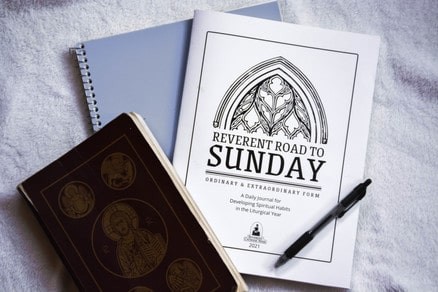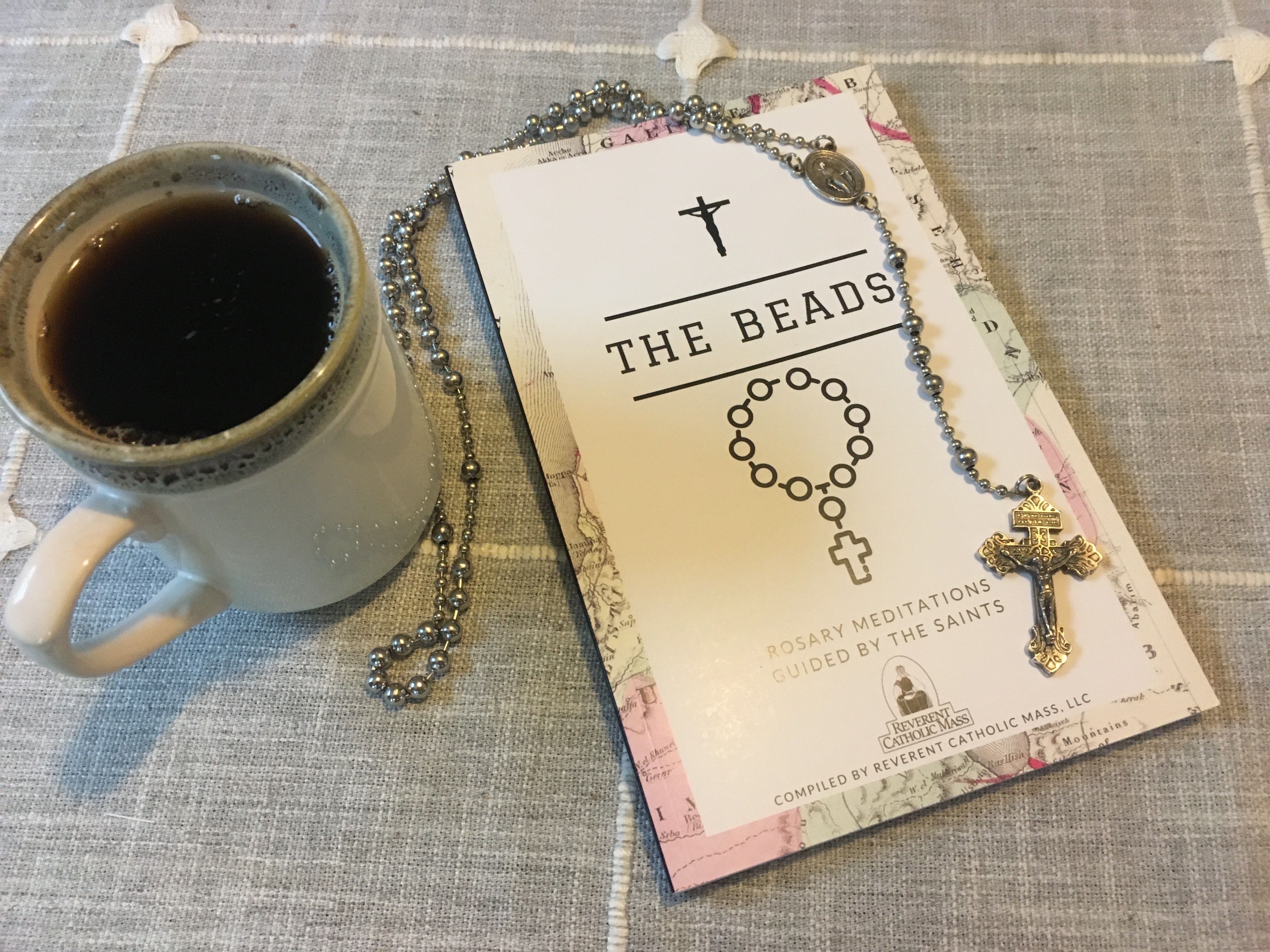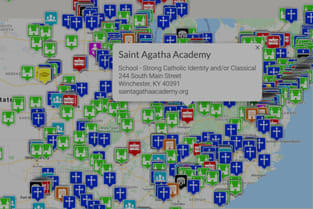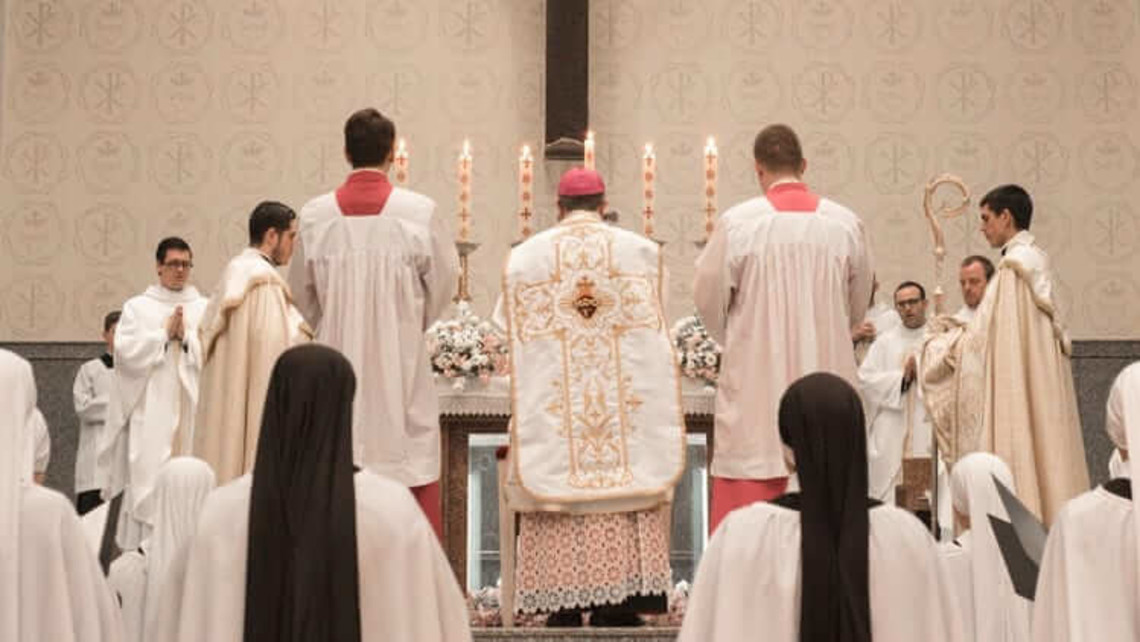
How to Easily Grasp The Latin Mass: A Step-by-Step Guide
Are you new, confused, or intimidated by the Traditional Latin Mass? Get simple, clear answers that explain each part of the Mass with brevity.
The unmistakable aroma of incense hit my nose as a polyphonic chorus echoed throughout the church. And then it began, "In nomine Patris, et Filii, et Spiritus Sancti, Amen. Introibo ad altare Dei."
Have you been hearing a lot about the Traditional Latin Mass recently but have no idea where to begin?
I know the feeling.
I grew up with the Ordinary Form of the Mass and still attend it regularly, so when I went to my first Traditional Latin Mass or Extraordinary Form Mass, I was completely perplexed.
I brought my daily missal with me only to find out the readings were different. I could not understand the prayers (the whole Latin part) and I was shocked at how much the altar boys had to do.
I remember when I was an altar boy, the only job I was trusted with was to carry the processional cross at the beginning and end of Mass, and even then I was confused about when to do it.
In the Traditional Latin Mass or Extraordinary Form, everything is different and needs to be explained. There's no missalette, no felt banners, and the priest even wears a strange looking hat!
Bonus: Download a free Mass guide to bring to Mass for both the Traditional Latin Mass or Ordinary Form. {Printable}
No wonder many people are intimidated by the Extraordinary Form. Before going to your first Traditional Latin Mass, I want to recommend you read our post, The Ultimate Simple Guide to Catholic Mass. It shows the similarities between the Ordinary Form or Novus Ordo and Extraordinary Form or Traditional Latin Mass. The guide can also be printed so you can pray some simple prayers of the Mass with without fully knowing what is happening.
This post is intended to explain briefly each part of the Latin Mass, where the parts come from, and why they are part of the Mass.
Once you have this basic understanding, you're ready to follow along with a Missal (recommendations at the end).
Must-Know Jargon for Latin Mass Explanation:
The Ordinary of the Mass – The prayers and rites that are fixed and do not change from day-to-day.
The Propers of the Mass – The prayers which vary according to the feast day or liturgical season
The Epistle Side – When facing the altar from the pew, it is the right side of the altar.
The Gospel Side – When facing the altar from the pew, it is the left side of the altar.
Related: What Everyone Should Know About Ad Orientem Worship
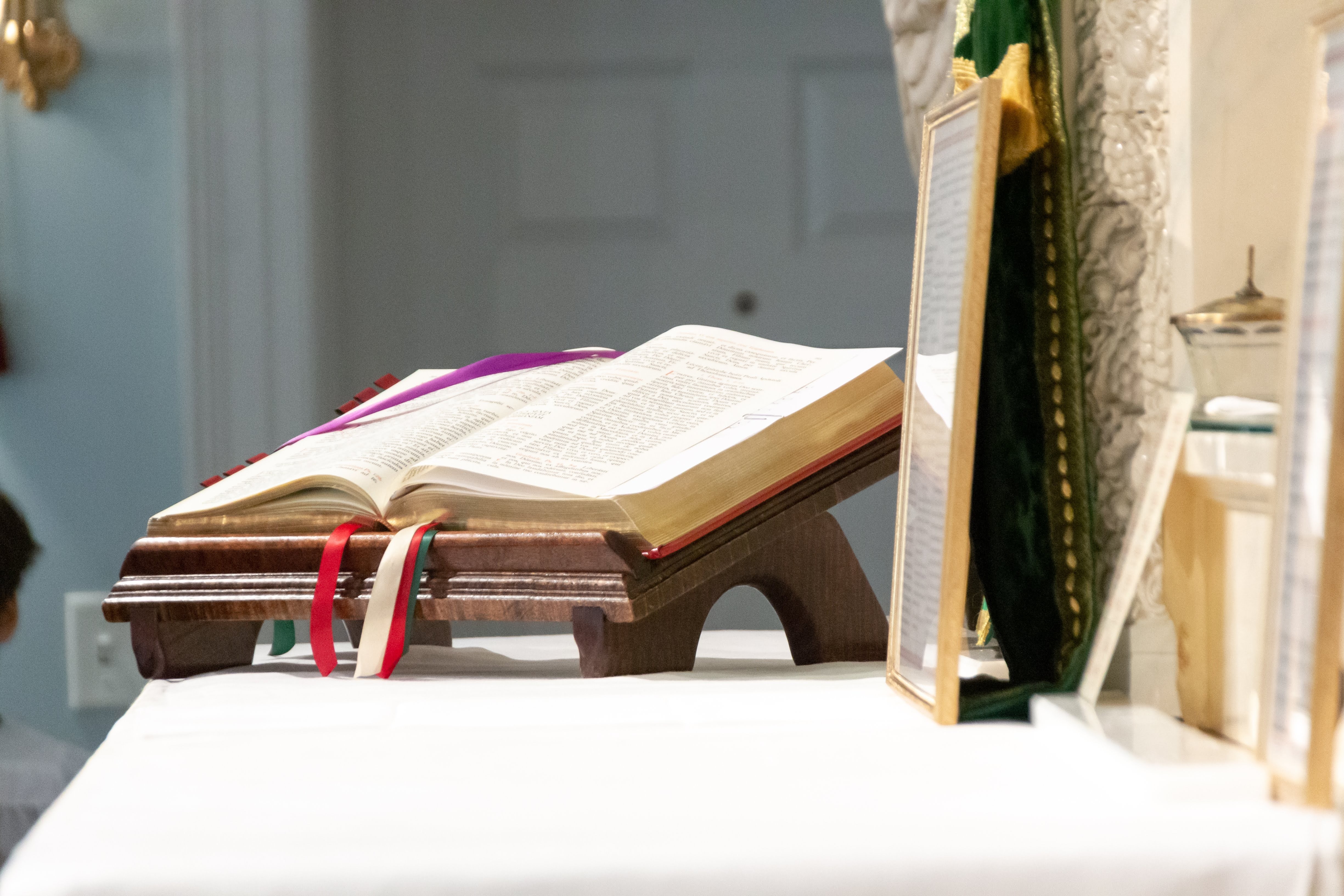
Parts of the Mass:
The Extraordinary Form is divided into 2 parts, the Mass of the Catechumens and the Mass of the Faithful.
The Mass of the Catechumens has 2 sections: The Preparation and the Instruction.
The Mass of the Faithful has 3 sections: The Offertory, the Canon of the Mass, and the Communion. (The Communion is subdivided into 4 segments).
This rundown is for a typical Low or High Mass.
I. The Mass of the Catechumens
It is called "The Mass of the Catechumens" because in the early Church, the Catechumens were only allowed to attend the first part of the Mass. Catechumens are the unbaptized, in training, who desire to be Catholic.
They would only be allowed to hear readings from the Old Testament or Epistles, read from the Epistle Side of the altar. This side of the altar was understood to be for instruction on how to live the Christian life.

The charts are for a typical High Mass. In a Low Mass, you generally remain kneeling until the Gospel. Stand for the Gospel & Creed. Sit through the Offertory until the Sanctus to kneel. You kneel until the Last Gospel when you stand.
ALL CAPS & ITALICS = THE PROPERS
Colors = Location of the Priest
Yellow = Foot of the Altar
Green = Epistle Side (right side)
Red = Middle of the Altar
Blue = Gospel Side (left side)
(K) = Kneel, (ST) = Stand, (S) = Sit
Bonus: Download a free Mass guide to bring to Mass for both the Traditional Latin Mass or Ordinary Form. {Printable}
A. The Preparation at the Foot of the Altar
1. The Sign of the Cross
“The Mass starts with the sign of the Trinity, the incarnation, and our redemption.” [1]
2. Psalm 42*
The priest, on our behalf, is humbled at the foot of the altar pleading with God. King David wrote Psalm 42 in the midst of battle, surrounded by enemies, and after he had sinned, and pleaded with God for deliverance from spiritual enemies.
This Psalm also represents Jesus in the Garden of Olives and expresses the priest's desire to be near God in the Eucharist, his trust in God, and his unworthiness.” [2]
*In Contemporary Bibles the Psalms are numbered slightly different and list this now as Psalm 43.
3. The Confiteor or Public Confession
Confiteor means, "I confess". Taking responsibility for our offenses against God and others we ask for the assistance of Our Lady and the Saints to aid us in our rejection of sin. We strike our breast because that is where our heart is located. Our sinful heart is the cause of our sin and deserves to be broken and destroyed so God may make us clean and new. [3]
4. The Introit
Introit in Latin means "he enters" and is usually from the Psalms but not always. It sets the tone for the kind of Mass being offered depending on the feast day. In the ancient Church, it was chanted while the priest and his attendants entered in procession to the altar. [4]
Bonus: Download a free Mass guide to bring to Mass for both the Traditional Latin Mass or Ordinary Form. {Printable}
5. The Kyrie Eleison
Kyrie Eleision means, "Lord have mercy." We're like the crippled blind men sitting on the side of the road crying out to Jesus with hope that He will have compassion and mercy on us, as described in Matthew 20:31.
It is the only part of the Mass in Greek and when added to the Mass hundreds of years ago, many believed if it were translated into Latin, it would have lost its original meaning. More here.
6. The Gloria in Excelsis
The Gloria begins with the words from Luke 2:14 of the angels' hymn on the night of the Our Savior’s birth.
It brings together the “four ends of the Sacrifice of the Mass [5]” of Adoration, Thanksgiving, Atonement, and Petition, and is considered the Church's greatest hymn of praise.
Related: The Ultimate Simple Guide to Catholic Mass
B. The Instruction
1. The Prayer or Collects
The Collects is usually directed as an ardent appeal to God invoking the Trinity. It is believed the name Collects was given because “the priest collects together the prayers of all the people.” [6]
2. The Epistle or Lesson
Epistle comes from Greek meaning letter. The Epistle which also called "Lectio" or lesson is a reading from the Epistles of St. Paul or the New Testament. The ancient Church, in the Jewish Temple tradition, would listen to the reading of the Word during the Mass. [7]
These selections are instructive in nature on how to live the Christian life and follow Our Lord.
3. The Gradual
Gradual comes from the word “gradus” which means “step”. It used to be sung between the Epistle and Gospel as the deacon would ascend the steps of the ambo to sing the Gospel. [8]
- The Alleluia: Alleluia is Hebrew meaning "Praise ye the Lord,". It joyfully expresses the Church's feelings in the truths of the Gospel.
Bonus: Download a free Mass guide to bring to Mass for both the Traditional Latin Mass or Ordinary Form. {Printable}
4. The Munda Cor Meum
Munda Cor Meum means “Cleanse my heart” and is from Isaiah 6:6.
The angel took a live coal to the prophet’s lips, which signifies purity, and said, “Behold, this hath touched thy lips, and thy iniquities shall be taken away, and thy sin shall be cleansed.”
As followers of Christ, we should know the purifying message of the Gospel, keep it in our hearts, and proclaim it from our lips. The priest and the faithful make the sign of the cross on the forehead, lips, and heart before the reading of the Gospel to demonstrate this.
5. The Gospel
The word “Gospel” comes from the Anglo-Saxon word “god” (good) and “spell” (speak) and signifies good news.[9] An excerpt is read from either the book of Matthew, Mark, Luke, or John and is about Jesus Christ and what He did and taught.
- Homily - The homily which comes from the Greek word "homilia" meaning conversation is meant to be a commentary. The priest will usually deliver an explanation of the readings, words of encouragement, or instruction.
6. The Nicene Creed
The Creed is the public and solemn profession of the Catholic Faith.
The Apostles Creed used to be said but the Nicene Creed was formulated in the fourth century against the errors of the time to more clearly harmonize and define Catholic doctrine.[10]
Bonus: Download a free Mass guide to bring to Mass for both the Traditional Latin Mass or Ordinary Form. {Printable}
II. The Mass of the Faithful
At this point, in the ancient Church, the catechumens were then excluded from the rest of the Mass and only the baptized Faithful could remain.[11]

The charts are for a typical High Mass. In a Low Mass, you generally remain kneeling until the Gospel. Stand for the Gospel & Creed. Sit through the Offertory until the Sanctus to kneel. You kneel until the Last Gospel when you stand.
ALL CAPS & ITALICS = THE PROPERS
Colors = Location of the Priest
Yellow = Foot of the Altar
Green = Epistle Side (right side)
Red = Middle of the Altar
Blue = Gospel Side (left side)
(K) = Kneel, (ST) = Stand, (S) = Sit
Bonus: Download a free Mass guide to bring to Mass for both the Traditional Latin Mass or Ordinary Form. {Printable}
A. The Offertory
1. The Offertory Prayers
In the ancient Church, this short antiphon was chanted while the Faithful walked up to the sanctuary with their offerings of bread, wine, or other gifts for the Mass.
2. The Offering of the Host and Offering of the Chalice
During the offering of the host, Christ unites our petitions to the offering of Himself to the Father.[12]
The mixing of wine and a little water together expresses the incarnation. This is because the wine signifies Christ’s divinity while the water signifies our humanity. “Even as these few drops of water lose themselves in the wine, so may also we lose ourselves in the divinity of Christ.”[13]
3. The Lavabo
Lavabo means "I will wash" and is from Psalm 25:6.* The priest washing his hands symbolizes the internal purity expected of God's minister at the Holy Sacrifice.[14]
*Contemporary Bibles are Psalm 26:6.
Bonus: Download a free Mass guide to bring to Mass for both the Traditional Latin Mass or Ordinary Form. {Printable}
4. The Orate Frates
Orate Frates means "Brethren pray". As Christ offered Himself to God for our salvation, so too we must offer ourselves to God in sacrificial communion.
5. The Secret
The Secret prayer is said over the bread and wine and used to be the only prayer whispered so no one else could hear it, which is the reason it is called the Secret.
The priest acts as a mediator speaking directly to God on behalf of man like Moses on Mount Sinai.[15]
6. The Preface
The Preface, or introduction to the Canon, is a hymn of thanksgiving and praise. It is an invitation to the people to raise their hearts to God.
7. The Sanctus
The Sanctus combines the words of the seraphim sung before the throne of God from Isaiah 6:3 and the exclamations of the Jews in Jerusalem as Christ entered the city from Matthew 21:9.
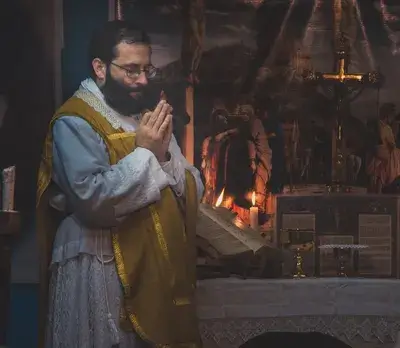
B. The Canon of the Mass
The word Canon comes from a Greek word and means authoritative rule.
The Canon of the Mass is the rule that must be followed to offer up the unbloody sacrifice and consecrate bread and wine into the body and blood of Jesus Christ. This is the most solemn, silent, and mysterious part of the Mass.
1. The Commemoration of the Church, the Living, and the Communicantes
Commemoration of the Church:
Three names are given to the bread and wine.
Gifts - We receive them from God
Presents - We offer to God
Holy and Unspotted Sacrifice - The expectation of consecration when these gifts will be changed into the body and blood of Our Lord.[16]
Commemoration of the Living:
God is asked to consider all those present at Mass who hope for salvation for themselves, their families, and their friends.
Communicantes:
We ask for help and protection from the Saints who are in eternal communion with God in Heaven.
Bonus: Download a free Mass guide to bring to Mass for both the Traditional Latin Mass or Ordinary Form. {Printable}
2. The “Hanc Igitur”
Reaching his hands over the bread and wine, the priest begs God to accept this offering in a similar custom to the ancient Jewish sacrificial rite.
3. The Consecrations and Elevation
Analogous to the Apostles and Our Lord together at the Last Supper, the faithful are together as the Consecration begins.
The Consecration of the Bread and Elevation of the Sacred Host
Our Lord at the Last Supper directed His Apostles to do this, in Matthew 26:26-28. The words of consecration and the elevation of the Consecrated Host and Chalice is a re-presentation of the crucifixion of Jesus.
The Consecration of the Wine and Elevation of the Chalice
The double consecration of bread and the wine into the Body and Blood of Our Lord represents the death of Christ by the separation of His Body and Blood.
4. The Prayers after of Consecration
The prayer after the consecration asks God to receive our Sacrifice like He received other sacrifices in the Old Testament from Abel (Gen. 4:4), Abraham (Gen. 22:1), and Melchisedech.
Melchisedech also offered a sacrifice of bread and wine to God similarly to Our Lord, Jesus Christ, who offers Himself daily under the appearance of bread and wine.[17] Gen 14:18
5. The Commemoration of the Departed and Saints
The priest prays to God for all the souls in purgatory.
The Catacombs of the first Christians are filled with inscriptions of refreshment, light, and peace.[18]
6. The Minor Elevation
The priest takes the Host in his right hand and the Chalice in his left, elevates them slightly and repeats the words of St. Paul from Romans 11:36.
Bonus: Download a free Mass guide to bring to Mass for both the Traditional Latin Mass or Ordinary Form. {Printable}
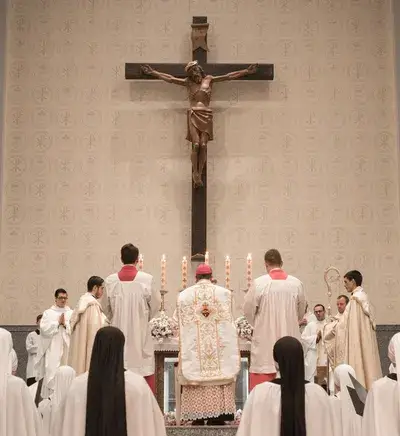
C. The Communion
(The Preparation)
1. The Pater Noster
In the ancient Church the Our Father was considered to be the only preparation worthy of Holy Communion.
It is taken from our Lord’s direction on how to pray Matt. 6:9-13.[19]
2. The Breaking of the Host
The breaking of the Host signifies the sacrificial nature of the Eucharist and symbolizes Christ’s bloody passion and death on the Cross.
When the priest drops a little piece of the sacred host into the chalice, it represents Christ is completely present under both species.
"As the separate consecrations of the sacred Body and Blood signify the death of Christ, so the uniting of the two sacred species represents His resurrection.”[20]
Bonus: Download a free Mass guide to bring to Mass for both the Traditional Latin Mass or Ordinary Form. {Printable}
3. The Agnus Dei
Angus Dei means Lamb of God and comes from St. John the Baptist who said, "Behold the Lamb of God, behold Him Who taketh away the sin of the world" (John 1:29).
The Old Testament also refers to Him as the Lamb of God in Jer.11:19 and Is. 53:1.
God commanded that at the Passover Feast spotless lambs were to be sacrificed. Jesus Christ fulfills the Old Testament by being the spotless, sinless Lamb who was sacrificed for our sins.
4. Prayer of Peace
The prayer of peace is a symbol of charity which should unite the faithful.
(The Reception of Communion)
5. The Prayers at the Communion
The priest repeats the words Psalm 115:12*. I will take the bread of Heaven and call upon the name of the Lord.
*Contemporary Bibles are Psalm 116:2.
6. The Domine, non sun dignus
In humility and confidence, the priest echoes the words of the Roman Centurion from Mat. 8:8.
7. The Communion of the Priest
The priest receives our Lord in Holy Communion.
8. The Communion of the Faithful
As an act of humility, the faithful say the words of the Roman Centurion from Matthew 8:8.
Related: The Ultimate Simple Guide to Catholic Mass
(The Thanksgiving)
9. The Ablution Prayers
We give thanks and praise to God that we can receive Christ physically in hope He might receive us divinely.[21]
10. & 11. The Communion Antiphon and Post Communion
These prayers are the Church's official thanksgiving after Communion and we pray we may live throughout the day changed because of it.
(The Conclusion)
12. The “Ite Missa Est”
Ite Missa est means "Go, it is the dismissal.", and comes from the word mittere, “to send”.
This is where the Mass got its name. We're now sent into the world to carry our own crosses and to live the Gospel boldly, proclaiming Christ to the world.
13. The Blessing
In the name of God, through the power of Christ, the priest blesses the Faithful.
14. The Last Gospel
This is a reading from John 1:1-14. It is read at the end of every Mass and Pope Pius V, in the 16th Century, inserted it in the Missal, because of how treasured it is to the faithful.
15. Deo Gratias.
Thanks be to God to have been given the privilege to witness and receive Our Eucharist Lord!
Missals and Guides:
A Missal is a book containing all the prayers and responses necessary for celebrating the Mass throughout the year.
A Guide is a booklet that contains information about what is going on in the Mass and why.
We own two Missals and both are excellent. Many of the references came from the Fr. Lasance Missal.
The New Roman Missal: Fr. Lasance
1962 Roman Catholic Daily Missal
Free Printable Missal with English/Latin Translation: Free Printable Latin Mass Missal
Children's Guide: This Free PDF Version of The Saint Edmund Campion Children's Missal was posted by Corpus Christi Watershed and is excellent for adults as well!
Bonus: Download a free Mass guide to bring to Mass for both the Traditional Latin Mass or Ordinary Form. {Printable}
Now that the Latin Mass has been explained, you can relax and attend this awe-inspiring Mass with reverence and devotion. And if anyone asks you about what the priest's strange hat is called, you can confidently answer them, "It a biretta!"
We hope this helps you feel a little more confident in attending the Mass of the Saints and understand a little better the depth and beauty contained within it.
PAX,
Tony and Kendra
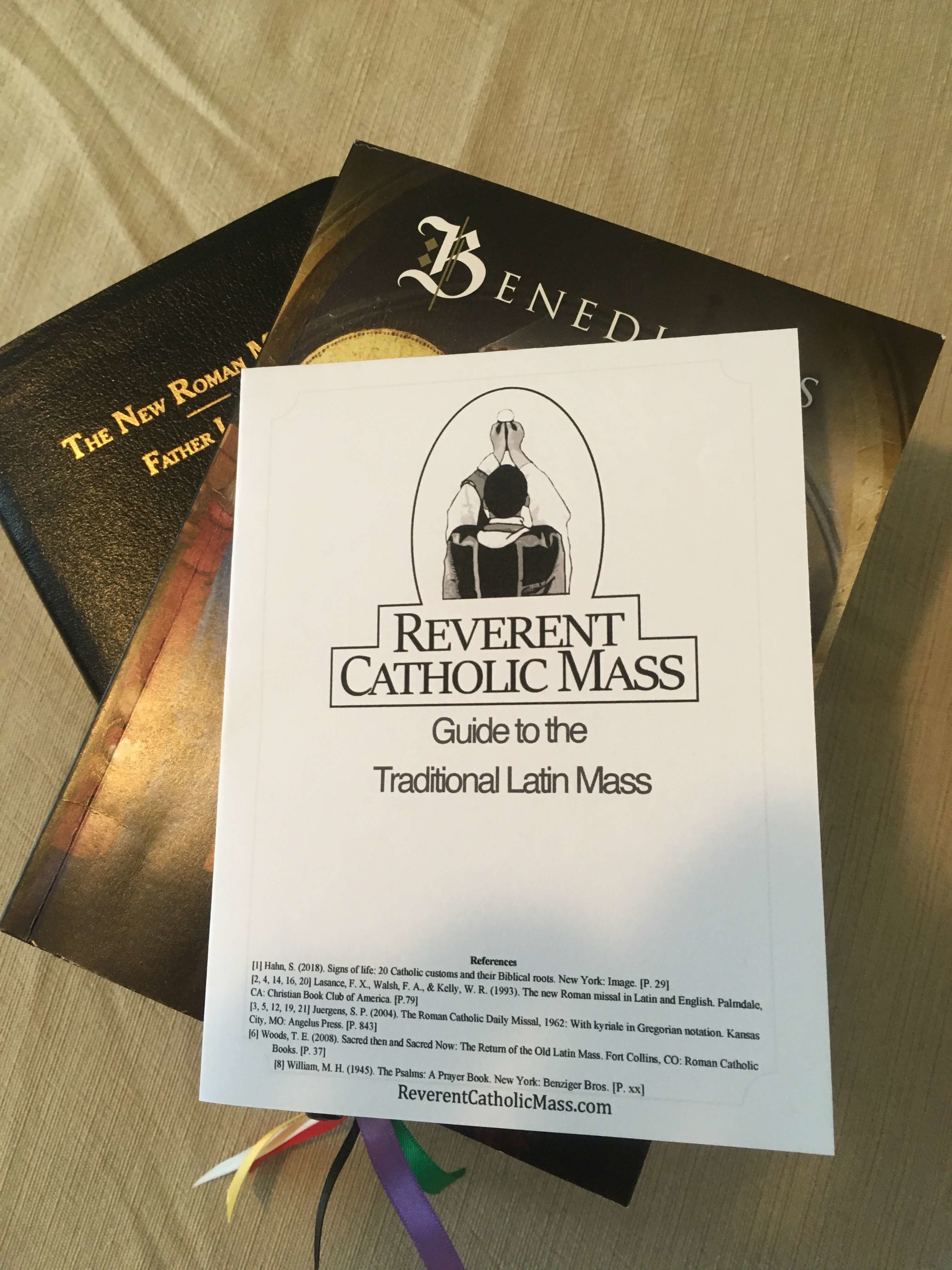
Download to Free Guide to the Latin Mass
References:
[1] Hahn, S. (2018). Signs of life: 20 Catholic customs and their Biblical roots. New York: Image. [P. 29]
[2] Lasance, F. X., Walsh, F. A., & Kelly, W. R. (1993). The new Roman missal in Latin and English. Palmdale, CA: Christian Book Club of America. [P.79]
[3] Juergens, S. P. (2004). The Roman Catholic Daily Missal, 1962: With kyriale in Gregorian notation. Kansas City, MO: Angelus Press. [P. 843]
[4] Lasance [P. 77]
[5] Jueugens [P. 849]
[6] Woods, T. E. (2008). Sacred then and Sacred Now: The Return of the Old Latin Mass. Fort Collins, CO: Roman Catholic Books. [P. 37]
[7] Lasance [P. 79]
[8] William, M. H. (1945). The Psalms: A Prayer Book. New York: Benziger Bros. [P. xx]
[9] Lasance [P. 80]
[10] Ibid.
[11] Lasance [P. 79]
[12] Jueugens [P. 859]
[13] Lasance [P. 82]
[14] Lasance [P. 88]
[15] Lasance [P. 85]
[16] Lasance [P. 87]
[17] Lasance [P. 91]
[18] Lasance [P. 92]
[19] Jueugens [P. 903]
[20] Lasance [P. 95]
[21] Jueugens [P. 915]


